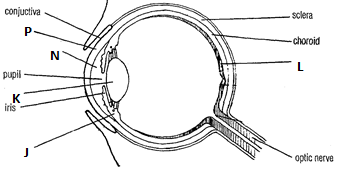- The diagram below represents a stage in cell division.
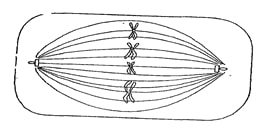
- Identify the stage of cell division (1mk)
- Give a reason for your answer (1mk)
- The diagram below shows a mammalian eye.
- Name the parts labeled J, K, and L ( 3mks)
- Explain how the following parts are adapted to their function.
- K ………………………………………………………………………………(1mk)
- P……………………………….………………………………………………(1mk)
- Name the eye defect caused by short eyeball and less refractive lens. (1mk)
- Outline two differences between plant divisions bryophyte and Pteridophyta (2mks)
- A certain animal had one cell from its alimentary canal observed under light microscope. A total of 40 chromosomes were seen.
- State the number of chromosomes in
- The spermatozoon of this animal (1 mk)
- One of cells in the tongue. (1mk)
- Name a structure in mature plant where meosis takes place. (1mk
- State the number of chromosomes in
- State one functions of golgi apparatus (mk)
- The concentration of lactic acid in blood during and after an exercise was determined. The results are shown in the graph below.
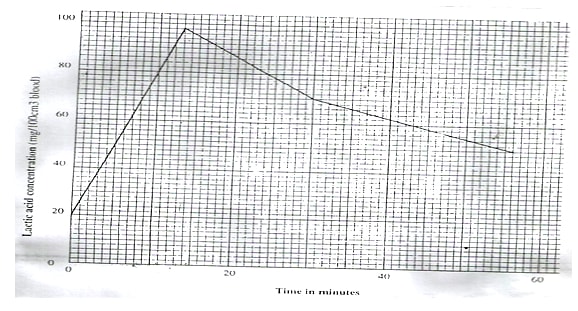
- By how much did the lactin acid increase at the end of 10 minutes? (1mk
- After how many minutes was the lactin acid concentration 78mg/100cm3 ( 2mks)
- What would be the concentration of lactin acid at the 60th minutes. (1mk)
- Give a reason for the high rate of production of lactic acid during the exercise. (1mk)
-
- What is meant by the term sex linkage. (1mk)
- Part of one strand of DNA molecule was found to have the following sequence
G-C-C- G – A – T- T – T – A – C – G – G
What is the sequence:- of the complimentary DNA strand? (1mk)
- On a m-RNA strand copied from this DNA portion? (1mk)
- Study the diagram below and answer the questions that follow.
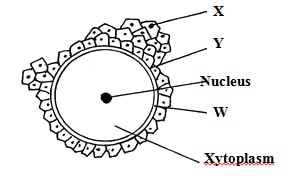
- Identify the cell (1mk)
- Label the parts X,Y and W (3mks)
- The diagram below shows a bone of the hind limb. Study it and answer the questions that follow.
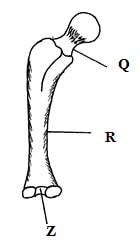
- Name the bone (1mk)
- Name the parts labelled Q and R (2mks)
- Name the structure that articulates with the part labeled Z and the joint formed? (2mks)
- State Two ways by which the ileum is adapted fro absorption of food materials? (2 mks)
-
- What is a teat pipette used for in Biology Laboratory Lesson? (1 mark)
- Give the name of a reagent that is used to test substances and at the same time used as a stain in the laboratory. (1mark)
- A form one student observing Onion epidermal cells under the low power objective counted 5 cells on a field of view measuring 5mm
- Estimate the size of one cell. (1 mark)
- If the eye piece magnification used was × 10 and that of the objective lens was × 10. What was the magnification of the microscope? Show your working. (2 marks)
Estimate by approximation the Number of cells that would be observed if the objective lens magnification was changed to x 4
- Name one cofactor and one co-enzyme required for a blood clotting process to be normal.
- Co-factor - …………………………………………………(1mark)
- co-enzyme - ………………………………………………….(1mark)
-
- What is counter current Mechanism in a Tilapia fish? (2marks)
- The diagram below represents an organ from a finned bony fish. Study it and answer the questions that follow
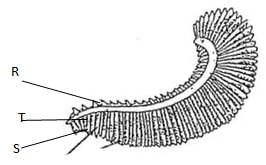
- Identify the organ. (1mark)
- State two adaptations of the part labeled S to its functions. (2 marks)
- The equation below represents a process that takes place in plants and animals
C6H12O6 + 6O2 = 6CO 2 + 6H2O- Name the process. (1 mark)
- State two requirements necessary for the process (a) above to process at maximum rate. (2 marks)
- What is the role of Cristae in the process above? (1 mark)
- In which part of the cell does glycolysis and Krebs cycle occur? (2 marks)
Glycolysis
Krebs cycle
- State two applications of Genetic in our day to day life. (2 marks
- State two functions of the cell sap. (2 marks)
-
- State two methods by which fossils were formed. (2 marks)
- What do similarity of wings of bats and those of insects illustrate? (1 mark)
- Give two reasons why Carolus Linneaus preferred the use of latin language in the scientific naming of living organisms. (2 mks)
-
- The diagram below shows part of a food relationship in an ecosystem
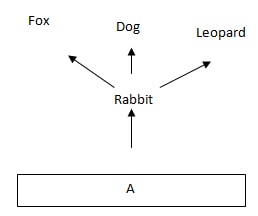
- Name the food relationship shown in the diagram (1mk)
- Name the trophic level occupied by organism A 1mk)
- What is the main source of energy in the ecosystem shown in the diagram above?
- The table below shows the percentage composition of blood plasma and urine for four substances
- Account for the absence of plasma proteins in urine (1mk)
- Urea concentration being greater in the urine than in the blood plasma (1mk)
- The diagram below shows part of a food relationship in an ecosystem
- An investigation was set up as shown in the diagram below.
After 30 minutes, starch suspension had turned blue-black while iodine solution retained its colour.- Name the physiological process that was being investigated in the experiment. (1mk)
- Account for the results observed after 30 minutes. (2mks)
- The diagram below illustrate part of phloem tissue.
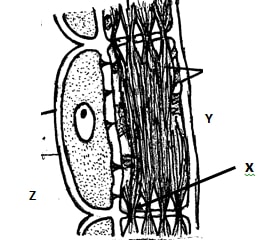
- Name the parts labeled. (2mks)
X………………………………………………………
Y………………………………………………………… - State the function of the part labeled Z (1mk)
- Name the parts labeled. (2mks)
- The following charts illustrate the quantity of urine passed out by four mammals of different species in different habitats.
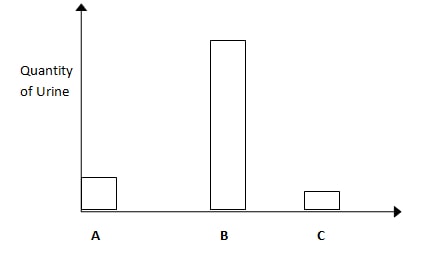
- Name the forms in which the following organisms are likely to excrete their nitrogenous wastes. (2mks)
Animal B
Animal C - Give two structural modification of the nephron of animal B that enables it to survive in its habitat. (2mks)
- Name the forms in which the following organisms are likely to excrete their nitrogenous wastes. (2mks)
- The diagram below represents the vertical section of a fruit.
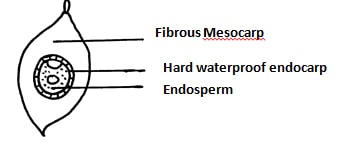
- Suggest the possible agent of dispersal of this fruit. (1mk)
- Explain two observable features that adapt the fruit to its mode of dispersal.(1 mk)

MARKING SCHEME
- The diagram below represents a stage in cell division.
- Identify the stage of cell division (1mk)
metaphase I - Give a reason for your answer (1mk)
- Chromosomes align themselves at the equator
- Chromosomes are all non- homologus
- Identify the stage of cell division (1mk)
- The diagram below shows a mammalian eye.
- Name the parts labeled J, N and L ( 3mks)
J- Ciliary body muscles
K- Lens
L-Retina - Explain how the following parts are adapted tot heir function.(i) N (1mk).
P- Transparent to allow light to pass through/curved to refract light.
K-Biconcave to refract light (1mk) - Name the eye defect caused by short eyeball and less refractive lens. (1mk)
Hypermetropia/Long sightedness
- Name the parts labeled J, N and L ( 3mks)
- Outline two difference between plant divisions bryophyte and Pteridophyta (3mks)
A certain animal had one cell from its alimentary canal observed under light microscope. A total of 40 chromosomes were seen.BRYOPHYTA
PTERIDOPHYTA
- Plant body is thalloid
Plant body differentiated into roots/stems and leaves
- Lacks vascular bundles
Has vascular bundles
- Gametophyte is dorminant generator
Sporophyte is dorminant generation
- State the number of chromosomes in
- The spermatozoon of this animal (1 mk
20 chromosomes - One of cells in the tongue. (1mk)
40 chromosomes
- The spermatozoon of this animal (1 mk
- Name a structure in mature plant where meosis takes place. State two function of golgi Apparatus (2mks)
Packaging of glycoprotein
Transporting of glycoprotein
Fromation of leygsomes
- State the number of chromosomes in
- The concentration of lactic acid in blood during and after an exercise was determined. The results are shown in the graph below.
- By how much did the lactin acid increase at the end of 10 minutes? (1mk)
60mg/100 cm3 - After how many minutes was the lactin acid concentration 78mg/100cm3 ( 2mks)
10 min and 25 min - What would be the concentration of lactin acid at the 60th minutes. (1mk)
47mg/100 cm3 - Give a reason for the high rate of production of lactic acid during the exercise. (1mk)
Oxygen supply to the tissues is less than oxygen demand leading to anaerobic respiration that produce lactin.
- By how much did the lactin acid increase at the end of 10 minutes? (1mk)
-
- What is meant by the term sex linkage. (1mk)
These are genes located on the sex chromosomes and are transmitted together with those determine sex - Part of one strand of DNA molecule was found to have the following sequence
G-C-C- G – A – T- T – T – A – C – G – G
What is the sequence?:-- of the complimentary DNA strand? (1mk)
C – G – G – C – T – A – A – A – T – G – C – C - On a m-RNA strand copied from this DNA portion? (1mk)
C – G – G – C – U – A – A – A – U – G – C – C
- of the complimentary DNA strand? (1mk)
- What is meant by the term sex linkage. (1mk)
- Study the diagram below and answer the questions that follow.
- Identify the cell (1mk)
Mature human ovum - Label the parts X,Y and W (3mks)
X – follicle cell
Y – viteline membrane
W – Plasma membrane
- Identify the cell (1mk)
- The diagram below shows a bone of the hind limb. Study it and answer the questions that follow.
- Name the bone (1mk)
Femurs - Name the parts labelled Q and R (2mks)
Q – neck
R – Shaft - Name the structure that articulates with the part labeled Z and the joint formed? (2mks)
Structure
Structure - patella
Joints – hinge joint
- Name the bone (1mk)
- State two ways by which the ileum is adapted fro absorption of food materials? (2 mks)
- It is long to provide large surface area for absorption.
- It is numerous to bring digested food into close contact with walls of the ileum for easier absorption.
- Highly coiled to slow down movement of food, allowing more time for absorption.
- Higher surface has large number of villi and micro-villi which increase the surface area for absorption of end products of digestion.
- Presence of thin layer of cells through which digested food diffuses.
- Presence of tense network of blood capillaries in villi into which nutrients are absorbed.
- Presence of lacteals in the villi for absorption of fatty acids and glycerol.
-
- What is a teat pipette used for in Biology Laboratory Lesson? (1 mark)
Transfer of reagents in drops during biology tests; - Give the name of a reagent that is used to test substances and at the same time used as a stain in the laboratory. (1mark)
Iodine solution;
- What is a teat pipette used for in Biology Laboratory Lesson? (1 mark)
- A form one student observing Onion epidermal cells under the low power objective counted 5 cells on a field of view measuring 5m
- Estimate the size of one cell. (1 mark)
- If the eye piece magnification used was × 10 and that of the objective lens was × 10. What was the magnification of the microscope? Show your working. (2 marks)
Total Magnification Eye peiece magnification
Mg × 10 × 10.
=100 - Estimate by approximation the Number of cells that would be observed if the objective lens magnification was changed to x 40 (1mark)
less than 5 i.e 4,3,2,or 1;
- Estimate the size of one cell. (1 mark)
- Name one cofactor and one co-enzyme required for a blood clotting process to be normal.
- Co-factor - Calcium/note reject ca ++ (1mark)
- co-enzyme - vitamin K/ Reject Vitamin (1mark)
-
- What is counter current Mechanism in a Tilapia fish? (2marks)
Mechanism where flow of blood is in the opposite direction of water flowing over the gills; to create a steep concentration greatest for gaseous exchange to occur by diffusion; -
- - Gill/ Reject Gills
- - highly vascularised for transportation of gases
thin epithelium to reduce distance travelled by diffusing gases
- large surface area for gaseous exchange
- What is counter current Mechanism in a Tilapia fish? (2marks)
- The equation below represents a process that take place in plants and animals
C6H12O6 + 6O2 6CO 2 + 6H2O- Name the process. (1 mark)
Aerobic Respiration; (reject respiration only) - State two requirements necessary for the process (a) above to process at maximum rate. (2 marks)
Respiratory Enzymes as catalysts;
suitable) optimum temperature
Optimum pH; - What is the role of Cristae in the process above? (1 mark)
Provides a large surface area for respiratory enzymes to work; - In which part of the cell does glycolysis and Krebs cycle occur? (2 marks)
Gycolysis - cytoplasm
Krebs cycle - matrix
- Name the process. (1 mark)
- State two applications of Genetic in our day to day life. (2 marks)
Genetic counseling;
Plant and Animal breeding;
Genetic Engineering; - State two functions of the cell sap. (2 marks)
- Offers turgidity of the cell contributing to mechanical support;
- Regulates the osmotic pressure of the cell, of the plant;
- Contains sugars ions and waste products;. -
- State two methods by which fossils were formed. (2 marks)
Petrification: changing into rocks
Preservation of the entire organism or it’s parts in ambers, plants resins or ice. - What do similarity of wings of bats and those of insects illustrate? (1 mark)
Convergent evolution
- State two methods by which fossils were formed. (2 marks)
- Give two reasons why Carolus Linneaus preferred the use of latin language in the scientific naming of living organisms. (2 mks)
Latin language was widely spoke and used by scientists during his time
Local names used previously could not be understood by everyone thus Latin is language enhanced scientific communication worldwide. -
- The diagram below show part of a food relationship in an ecosystem
- Name the food relationship shown in the diagram (1mk)
Food web - Name the trophic level occupied by organism A (1mk)
Primary producer/producer; - What is the main source of energy in the ecosystem shown in the diagram above? (1mk)
The sun / sunlight
- Name the food relationship shown in the diagram (1mk)
- The table below shows the percentage composition of blood plasma and urine for four substances
Component substance
Blood plasma %
Urine %
Urea
Water
Plasma proteins
Glucose
0.03
90
8.0
0.1
2.0
90
0
0
- Account for the absence of plasma proteins in urine (1mk)
Plasma protein molecules are too large to filter through the blood capillaries in the glomerulus; - Urea concentration being greater in the urine than in the blood plasma (1mk)
Due to reabsorption of water while urea is not reabsorbed
- Account for the absence of plasma proteins in urine (1mk)
- The diagram below show part of a food relationship in an ecosystem
- An investigation was set up as shown in the diagram below.
After 30 minutes, starch suspension had turned blue-black while iodine solution retained its colour.- Name the physiological process that was being investigated in the experiment. (1mk)
Diffusion; rj osmosis - Account for the results observed after 30 minutes. (2mks)
(Visking is semi-permeable; allowing the smaller molecules of iodine to pass across ( to the starch suspension) while the larger starch molecules cannot across ( to the iodine solution);
- Name the physiological process that was being investigated in the experiment. (1mk)
- The diagram below illustrate part of phloem tissue.
- Name the parts labeled. (2mks)
X – sieve pore;
Y – Cytoplasmic strands /filaments - State the function of the part labeled Z (1mk)
Has (numerous) mitochondria that provides energy for translocation;
Provides food nutrient to the sieve element;
- Name the parts labeled. (2mks)
- The following charts illustrate the quantity of urine passed out by four mammals of different species in different habitats.
- Name the forms in which the following organisms are likely to excrete their nitrogenous wastes. (2mks)
Animal B : ammonia;
Animal C : Uric acid; - Give two structural modification of the nephron of animal B that enables it to survive in its habitat. (2mks)
Posses larger glomeluli to increase ultra filtration;
Possesses a shorter loop of henle to minimize reabsorption of water;
- Name the forms in which the following organisms are likely to excrete their nitrogenous wastes. (2mks)
- The diagram below represents the vertical section of a fruit.
- Suggest the possible agent of dispersal of this fruit. (1mk)
Water - Explain two observable features that adapt the fruit to its mode of dispersal. (1 mk)
Fibrous mesocarp is air –filled to promote boutancy (on water0;
Hard waterproof endocarp ensure the seed/embryo does not soak ( in water);
- Suggest the possible agent of dispersal of this fruit. (1mk)
Download BIOLOGY PAPER 1 - 2019 LANJET JOINT MOCK EXAMINATION.
Tap Here to Download for 50/-
Get on WhatsApp for 50/-
Why download?
- ✔ To read offline at any time.
- ✔ To Print at your convenience
- ✔ Share Easily with Friends / Students

